Having plenty of website visitors doesn’t necessarily mean all of them will turn into customers. Some might leave after 5 seconds, and others might stay for a while but end up not even converting to leads.
So, you need to know how to optimize your site to make sure you’re increasing the number of users who turn into leads. Luckily, there are lots of different techniques you can use to generate more leads through your website to reach your sales goals.
And in this guide, we are going to look at ten foolproof tricks you can use to capture more leads through your website. Read on to learn more.
In this article
- 1. Offer a free lead magnet
- 2. Install a live chat feature
- 3. Add contact forms to your web pages or posts with a lot of traffic
- 4. Take advantage of pop-ups
- 5. Publish case studies that show you’re great at what you do
- 6. Create content that positions you as an expert and authority
- 7. Make sure your homepage is optimized
- 8. Map content to every stage of the buyer journey
- 9. Harness the power of strong calls-to-action
- 10. Provide social proof wherever possible
- Summary
1. Offer a free lead magnet
Creating lead magnets is one of the best techniques you can use to capture more leads on your website. People generally love freebies and if you’re able to offer them valuable resources as incentives, this will increase your chances of getting their contact details.
Some of the common lead magnets you can make are e-books, white papers, templates, webinars, or even free consultations. Including these types of valuable resources on your site can help you get the attention and contact information of website visitors who can then be moved into your sales funnel and nurtured into customers.
However, you want to be sure that your audience actually wants and needs these resources so you aren’t just creating them in vain. One way to find out what your target audience wants is to join relevant social platforms like Reddit or Quora and then look out for discussions about relevant topics and issues in your niche.
When you find these conversations, you can start to read through them and this will help you think of valuable resources you can create as lead magnets to solve some of the pain points your ideal customers are facing.
2. Install a live chat feature
You may have noticed that almost every website has a live chat feature nowadays. However, it’s not just for fun, this is because live chats have proven to be a very effective tool for generating leads.
They act as a guide when visitors need some assistance and they can be used to start conversations with people who aren’t sure of what to do next on your site. You can even integrate your customer service team with a live chat feature so visitors can get in touch with a real representative when they ask a question that needs customized solutions.
Let’s take a look at how Sleeknote does this on their website.
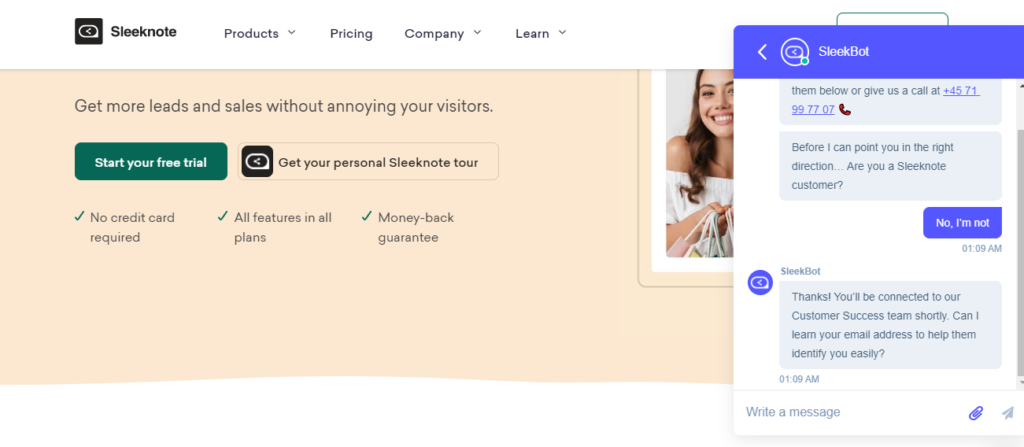
Sleeknote is a lead generation tool that helps businesses to engage their website visitors. And they do a great job of practicing what they preach. On their website, you’ll see that they’ve included a chatbot, or sleekbot, that can help point website visitors in the right direction.
The live chat feature also allows them to collect the contact details of potential clients and connect them with the company’s customer service representatives who can provide detailed answers to whatever questions people might have. You can also consider taking advantage of the live chat feature and integrating it with your customer service personnel to get the most out of it.
3. Add contact forms to your web pages or posts with a lot of traffic
If you notice that there are some pages or posts on your site that get more traffic than others, it means there is an opportunity for you to get more leads from them.
But first, you’ll need to figure out the pages that have high-traffic. And to do this, you can simply open up Google Analytics or any other analytical tool of your choice to identify the busiest pages with the most activity or page views.
Once you’ve seen them, make sure you add relevant contact forms or lead magnets like free consultations that require visitors to enter in their details so you’ll be able to capture more leads.
4. Take advantage of pop-ups
A pop-up is a small window that suddenly appears or pops up when you are on a website and it’s usually used to prevent people from leaving a site. Even though some people might find pop-ups distracting, they can still be very effective for getting leads.
According to Sumo, the average pop-up conversion rate is between 3.09% to 9.28%. This means, even if you only get 200 visitors in a day, you’d still be able to get 184 – 548 sign ups every month.
However, you need to know how to use pop-ups effectively if you want to see this kind of results. Make sure that you time the pop-ups not to appear immediately when people get on the page but, instead, after they might have spent some time on your site. Also, you want to ensure you use pop-ups that are relevant to each web page or post to increase your chances of turning visitors into leads.
To give you a practical example, let’s look at how Getresponse does this.
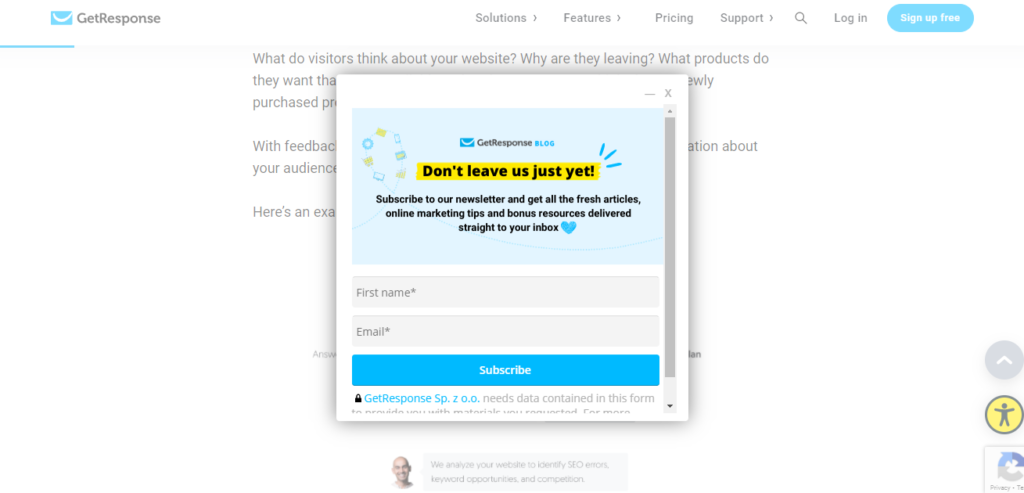
For example, see how Getresponse, one of the popular email marketing platforms in the industry does well in using pop-ups to get more leads. This pop-up appeared after I had gone through 70% of the article which is neither too early nor too late. Also, it promises access to new and fresh marketing tips and this would be very useful to a lot of people who come to their website.
By using these tactics, they’ve been able to increase the likelihood that a visitor will be interested in filling in their details instead of just ignoring the pop-up. This is a technique that can help you attract and capture more leads, so it’s worth trying it out on your website.
5. Publish case studies that show you’re great at what you do
In order to generate leads and make more sales, you need to earn the trust of your prospective customers, and the best way to do this is by showing them what you’ve already done.
This is where case studies come in. Publishing case studies is ideal for showing the results you’ve achieved in the past and sharing the thoughts of your previous customers. They are also great resources that can be used in a high-converting marketing funnel to turn more prospects into customers.
Let’s take a look at the way Drift uses case studies to show their expertise so you can get some inspiration.
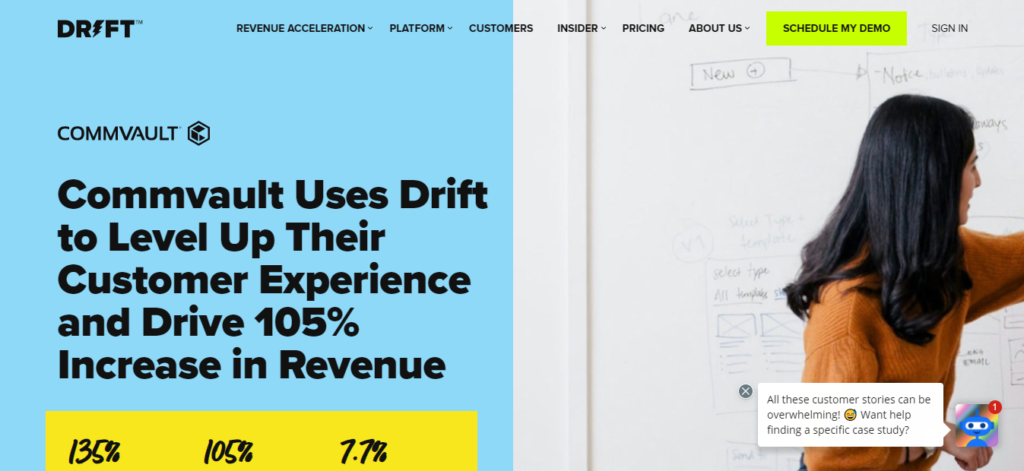
Drift is a company that uses conversational AI tools to help customers increase engagement for their brands. On their website, they have a case study that explains how they were able to help a client improve their customer experience and drive up revenue by 105%. The post outlines the challenges the client had at the beginning of the project, the solutions that Drift came up with, and the results that they were able to see at the end of the project.
This positions Drift as an expert in what they do and it can also help them attract new leads who are impressed by the results Drift was able to get for this customer. You can replicate this for your site by creating a guide just like this that shows how your company has been able to create positive results for clients.
6. Create content that positions you as an expert and authority
Not only can showing off your expertise and building authority in your field help you to earn the trust of your prospective customers, but it can also boost your SEO. Regardless of whether you run a digital agency, a web development company or a consulting firm, in order to achieve this, you need to create the right types of content.
Ultimate guides and tutorials are particularly great for demonstrating your expertise. Ultimate guides are comprehensive pieces of content that explain all there is to know about a specific topic, while how-to guides allow you to teach your audience how to perform a specific task.
You could also create webinars, which are essentially live or pre-recorded videos that help you explain or provide more information for your audience. Lastly, you could populate your blog with posts about developments in your industry, so you become a resource people use to stay up to date with all of the latest news.
Here is an example of a company that is doing a great job of establishing authority in their respective fields using these types of content.
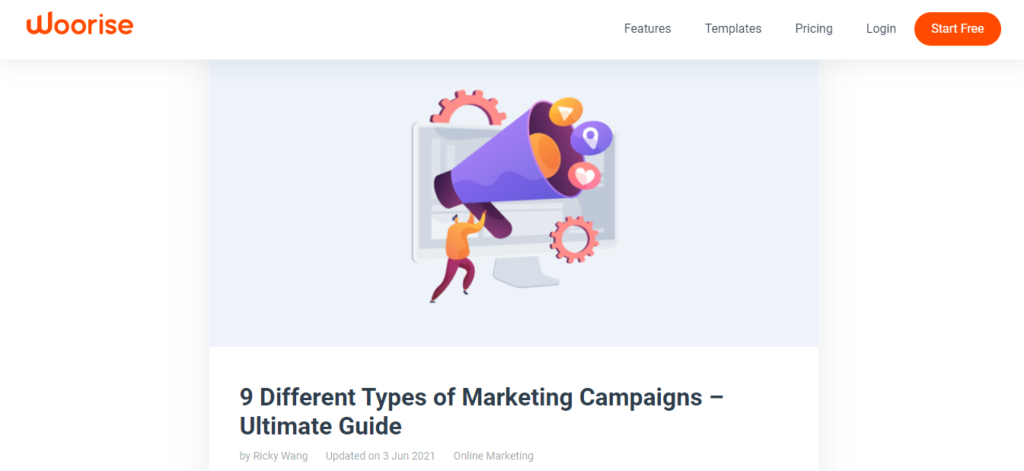
Lastly, here’s an example from Woorise. They have a blog post on the 9 different types of marketing campaigns that businesses should be using. They explain what a marketing campaign is, the different types, and even give practical examples that can help readers understand their concepts better.
It is the type of content that people usually use to establish authority in their industry and this piece works really well because of how much value it provides. It can also inspire more trust from prospective customers as it really shows that the company knows its way around the marketing industry.
One thing you can learn from these examples is the importance of making sure your content is comprehensive and well-detailed because that helps to make people view you as an authority in your niche.
7. Make sure your homepage is optimized
A lot of companies focus on optimizing their service or product pages and content, but neglect to use the same strategies for their homepages. But this is often the page people will land on first, which means you need to put plenty of effort into getting it right to make it a high-converting page.
One of the most important things to do is ensure it’s as easy as possible for people to take the next step. You can do this by providing a sophisticated search tool that lets people find the products they need, or you could point people in the right direction with a strong call-to-action.
Another thing is you have to make it easy for people to contact you with questions or concerns. To do this, you can highlight your phone number or email address, so people can see them immediately when they land on your website.
Now let’s look at a website that does a great job of optimizing its homepage.
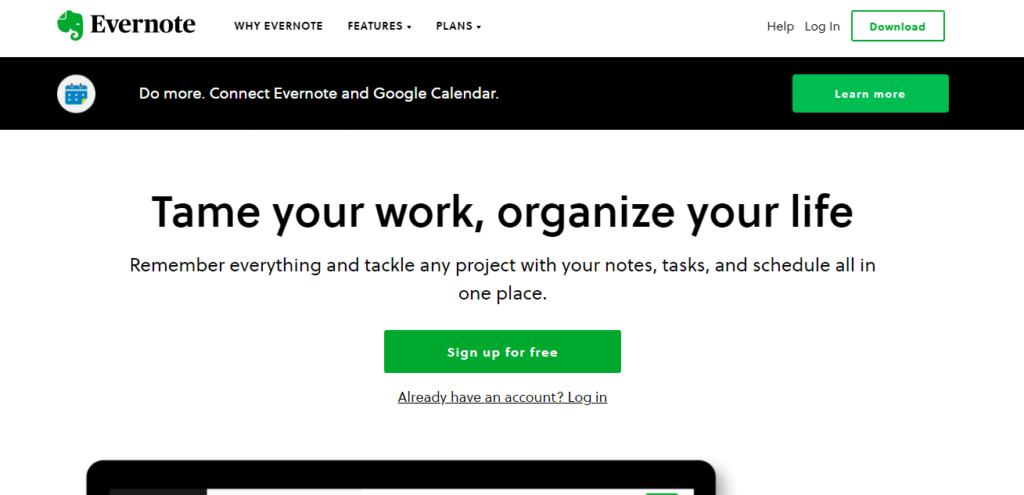
Evernote is a note-taking application that helps people to capture and have access to their ideas at any point in time. On their website, you’ll see that they’ve taken several steps to optimize their homepage.
You’ll find that they’ve included a very engaging and eye-catching video that explains the features of their tools as well as the benefits. Also, they’ve made it very easy for prospects to take the next step by using clear CTAs like “sign up for free” which tells people that they can get started with the app without making any financial commitment.
You could take a leaf out of the company’s book and replicate these tactics to generate more sales. You can focus on creating catchy calls-to-action that tell your audience what to do and also try to create catchy videos that explain how your product or service can help prospects. This will help to send a lot more people your way.
8. Map content to every stage of the buyer journey
One of the components of a successful marketing campaign involves creating content for each stage of your customers’ buying journey. People at different stages of the buying journey will have different needs, so you need to create content with this in mind.
For example, some people might not even know your services exist (and that they need them), while others might just be weighing up their options before making a purchase.
The three main stages of the buyer journey are awareness, consideration, and decision. The awareness stage is the point where people start to hear about your business and, for this, you can create informative blog posts that introduce people to your brand. Next is the consideration stage where you can use content like buying guides and product demonstrations to show the features and benefits of your products and why they’re great.
Lastly, you have the decision stage for people who are about to make a final choice on what to buy. You can make things easier for customers at this point by creating content like case studies that will encourage them to take action.
To provide you with some inspiration, let’s take a look at a company that has used web content to target people at the consideration stage of their sales funnel.
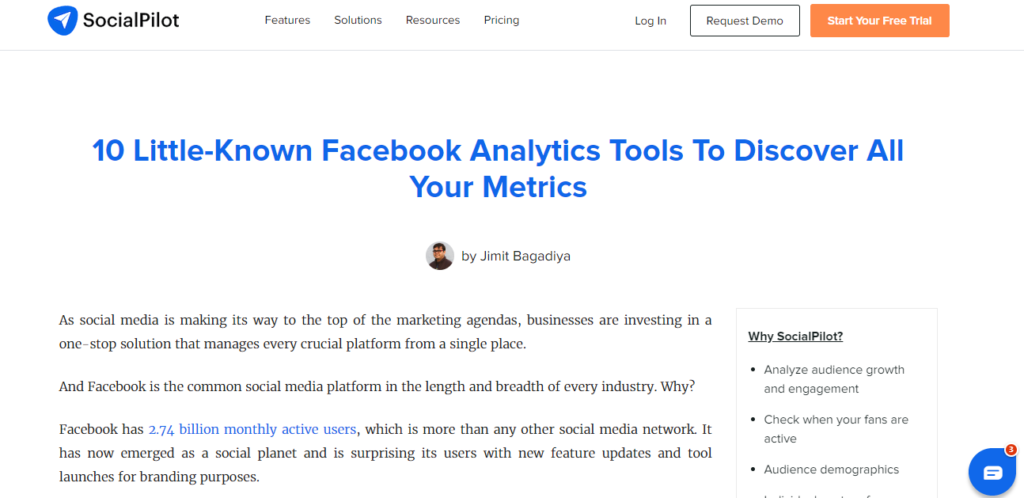
SocialPilot is a social media management company that allows businesses to manage their presence on social media. And, on their website, they have a comparison post that talks about 10 little-known Facebook analytics tools that people can use to discover marketing metrics. They include information about the benefits and disadvantages of each tool, and this is a great post that can help buyers make the best decision on which analytical tool to get.
For people in the consideration stage of their journey, this kind of content can be a great resource as it gives them all the information they need to pick the right option to suit their needs. It can also help in converting a lead into a customer, especially if you include your tool as part of the comparison post.
9. Harness the power of strong calls-to-action
If you want to turn website visitors into leads — and ultimately make sales — you’ll need to harness the power of strong calls-to-action (CTAs). They can help guide your visitors towards doing what you want, whether that’s to sign up to your mailing list or make a purchase. This is one of the best and most important landing page practices.
You should always start your CTAs with a strong verb that makes it clear what a website visitor should do next. For example, you could go with “sign up today”, “buy now”, or “get yours today”.
You can also use CTAs to inspire the fear of missing out (FOMO) in people who visit your site, so they feel like they’ll be making a mistake if they leave without taking action. Lastly, try to use eye-catching colors and bold fonts to make sure that your CTAs stand out from other elements on your website.
Now let’s study how an existing website uses strong calls-to-action to capture more leads.
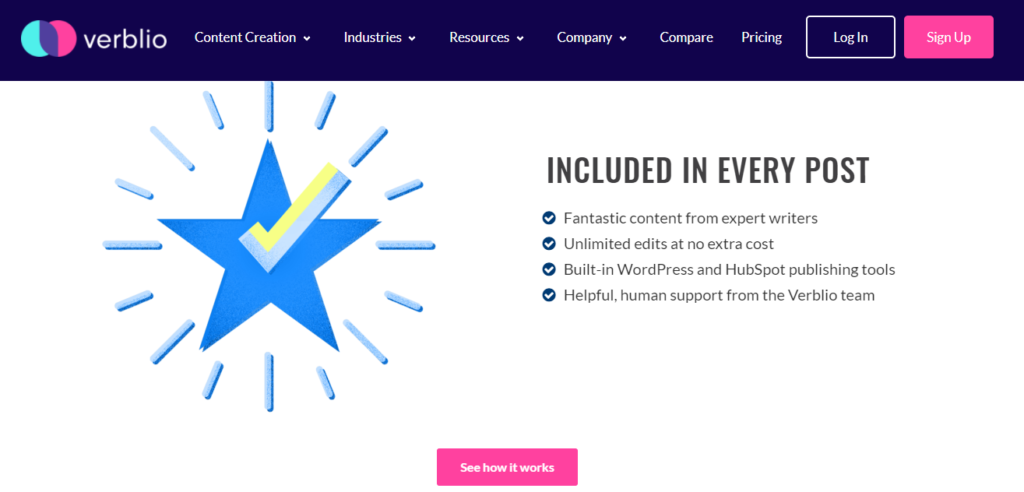
Verblio is a company that provides blog writing services and they’ve found a great way to harness the power of strong calls-to-action on their website. On their service page, you’ll find a number of CTAs that work well in converting visitors into leads. Some of these include “sign up”, “see how it works”, “request sample posts”, and “read case studies”.
These CTAs do a great job of grabbing people who might be at different stages of their buying journey with the company — there’s something for everyone. For instance, they give people in the awareness stage a chance to see how their service works, while allowing those in the consideration stage to see case studies on how the service has helped other clients. You should also consider creating multiple CTAs for your website if you want to speak to visitors who are at different stages in their buying journey. Use this example as inspiration.
10. Provide social proof wherever possible
Customer feedback is very important as people tend to trust word-of-mouth recommendations over marketing, so it’s a good idea to ask your customers for testimonials you can publish on your website. These will show that you’ve done a great job for your clients in the past and will help you generate even more leads for your business.
To ask customers for testimonials and reviews, you can start by sending a simple follow-up email asking about their experience of using a product or service that they got from you. You can also create survey polls and have these on your website to make it easier for customers to give feedback before leaving your website.
When you’ve gotten feedback or reviews, you’ll want to display them in the best way possible. One way you can do this is by highlighting them in a section of your homepage on a sliding carousel, so people can see all the reviews you’ve added. Another method is to have an entire webpage dedicated to just reviews, so you have enough space to add all the reviews and testimonials you’ve gotten from customers.
For inspiration, let’s take a look at how one company has chosen to display reviews on its website.
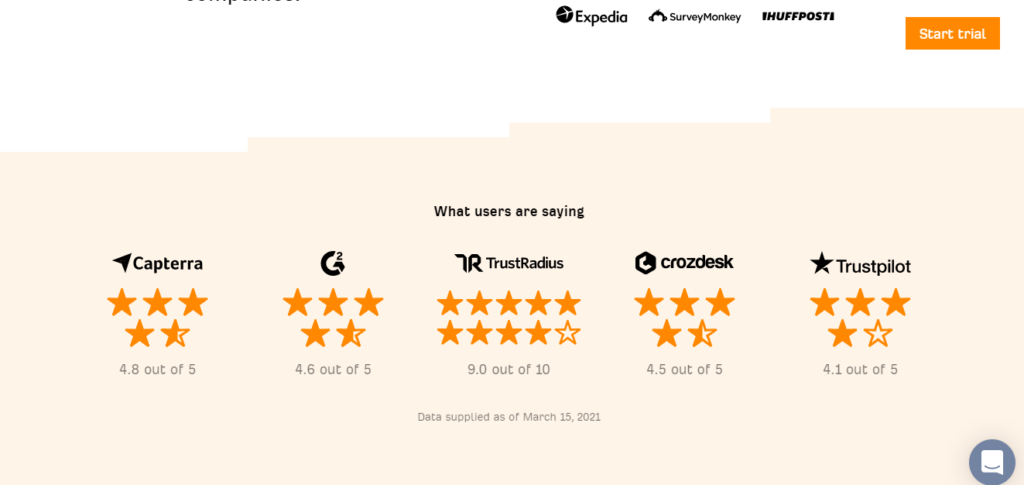
Ahrefs is an all-in-one SEO platform that provides tools for keyword research, link building, competitor analysis and other marketing needs. They understand the importance of displaying feedback, so they’ve made sure to include reviews from previous customers in a section of their homepage. These reviews are displayed in the form of star ratings and they actually show an overall score that’s gotten from all the reviews on individual review sites like Capterra, G2 and Trustpilot.
They also link to these sites so people can go over and see all the good testimonials given by those who have used one or multiple tools from Ahrefs. Displaying these reviews is a great way to show social proof and it’s a tactic that can help them convert more website visitors into leads.
When you want to display reviews from past clients, try to use this example as inspiration. If you sell products, simple star ratings will work well, while longer testimonials tend to make more sense for service-based companies that provide more bespoke help. Consider what kinds of reviews will work best for you, then display them on your site to capture more leads for your business!
Summary
Not everyone who visits your website will become a customer, but there are ways you can improve the odds that a good percentage will.
For example, you could try publishing case studies to show your expertise, optimizing your homepage, providing social proof, and taking advantage of strong CTAs. Aside from these, you can also utilize the power of lead-generation platforms like Woorise and their many features that will allow you to capture more customers than ever before.



